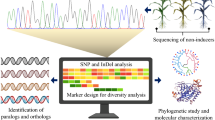Summary
-
1.
The length of the chromosome complements of T. monococcum, Ae. speltoides var. ligustica and Ae. squarrosa, the donors of the A, B and D genomes respectively of T. aestivum, varied in the ratio 1.0 ∶ 1.24 ∶ 0.76. The proportion of the total lengths of the chromosomes belonging to the A, B and D genomes in the bread wheat variety Chinese Spring, as calculated from the data of Sears (1954), also falls into a similar ratio (1.0 ∶ 1.28 ∶ 0.84).
-
2.
T. monococcum, T. dicoccum and T. aestivum differed in the proportion 1.0 ∶ 1.5 ∶ 2.0 as regards chromosome length and not as 1.0 ∶ 2.24 ∶
-
3.
0 as would be expected from the additive value of the total chromosome length of the concerned genome donors.
-
3.
The DNA content of individual nuclei in the species studied varied in proportion to chromosome length, thus indicating that the DNA content per unit length of chromosome is constant in the material studied.
-
4.
The type of karyotype asymmetry in the different Triticum and Aegilops species was classified according to the scheme of Stebbins (1958). The diploid species had the most symmetrical and the hexaploids, the most asymmetrical karyotype. No prominent heterochromatic segment could be detected in any of the species.
-
5.
The data indicate that a considerable degree of elimination of chromosomal material has taken place in tetraploid and hexaploid wheats subsequent to their origin. It is suggested that this might have been an important factor in the conversion of tetraploid and hexaploid wheats into functional diploids. A combination of the multivalent gene suppressor system and chromosome elimination appears to have led to a synthesis of the advantageous features of auto- and allo-polyploidy in tetraploid and hexaploid wheats.
Similar content being viewed by others
References cited
Bell, G. D. H., and L. Sachs: Investigations in the Triticinae II. J. Agric. Sci. 43, 105–115 (1953).
Bhaduri, P. N., and P. N. Ghosh: Chromosome squashes in cereals. Stain Technol. 29, 269–276 (1954); - Sat-chromosome of Triticum mocha — a unique feature among Triticum species. Cytologia (Tokyo) 20 (2), 148–149 (1955).
—, and A. T. Natarajan: The Punjab wheat C-591 — a chromosomal mutation. Indian J. Genet. and Pl. Breed. 16, 85–87 (1956).
Bhaskaran, S., and M. S. Swaminathan: Polyploidy and the genesis of the leguminous root nodule. Nucleus 1, 75–88 (1958); - Metaphase chromosome length and DNA content in relation to polyploidy in Triticum species. Exp. Cell. Res. 20, 598–599 (1960).
Kihara, H.: Die Entdeckung des DD-Analysators beim Weizen. Agric. Hort. Japan 19, 889–890 (1944).
—, and F. A. Lilienfeld: Genomanalyse bei Triticum und Aegilops. Untersuchungen an Aegilops X Triticum und Aegilops x Aegilops-Bastarden. Cytologia (Tokyo) 3, 384–456 (1932).
Kostoff, D.: Heterochromatin at the distal ends of the chromosome of Triticum monococcum. Nature (Lond.) 141, 690–691 (1938).
Marshak, A., and M. Bradley: X-ray inhibition of mitosis in relation to chromosome number. Proc. nat. Acad. Sci. (Wash.) 30, 231–237 (1944).
McFadden, E. S., and E. R. Sears: The origin of Triticum spelta and its free threshing hexaploid relatives. J. Hered. 37, 81–89 (1946).
Mirsky, A. E., and H. Ris: The composition and structure of isolated chromosomes. J. gen. Physiol. 34, 475–492 (1951).
Natarajan, A. T., S. M. Sikka and M. S. Swaminathan: Polyploidy, radiosensitivity and mutation frequency in wheats. Proc. Int. Conf. Peaceful Uses of Atomic Energy 27, 321–331 (1958).
Navashin, M.: „Amphiplastie“ — eine neue karyologische Erscheinung. Z. indukt. Abstamm.- u. Vererb.-Lehre Suppl. 2, 1148–1152 (1928).
Okamoto, M.: Further information on identification of the chromosomes in the A and B genomes. Wheat Inf. Service 6, 3–4 (1957).
Ornstein, L.: Distributional error in microspectrophotometry. Lab. Invest. 1, 250–265 (1952).
Patau, K.: Absorption microphotometry of irregular shaped objects. Chromosoma (Berl.) 5, 341–362 (1952).
Riley, R., and V. Chapman: Genetic control of the cytologically diploid behaviour of hexaploid wheat. Nature (Lond.) 182, 713–715 (1958).
—, J. Unrau and V. Chapman: Evidence on the origin of the B genome of wheat. J. Hered. 49, 90–98 (1958).
Sarkar, P., and G. L. Stebbins: Morphological evidence concerning the origin of the B genome in wheat. Amer. J. Bot. 43, 297–304 (1956).
Schrader, S. H., and F. Schrader: Polyteny as a factor in the chromosomal evolution of the Pentatomini (Hemiptera). Chromosoma (Berl.) 8, 135–151 (1956).
Sears, E. R.: Chromosome pairing and fertility in hybrids and amphidiploids in the Triticinae. Res. Bull. Missouri Agric. Exp. Sta. 337, 1–20 (1941).
—: Homoeologous chromosomes in Triticum aestivum. Genetics 37, 624 (1952).
—: The aneuploids of common wheat. Mo. Agric. Exp. Sta. Res. Bull. 572, 1–58 (1954); - The aneuploids of common wheat. Proc. First Int. Wheat Genet. Symp., 221–229 (1958).
—, and M. Okamoto: Intergenomic chromosome relationships in hexaploid wheat. Proc. Tenth Int. Cong. Genet. 2, 258–259 (1958).
Stebbins, G. L.: Variation and Evolution in Plants. Columbia Univ. Press 1950. 643 pp.; - Longevity, habitat and release of genetic variability in the higher plants. Cold Spr. Harb. Symp. quant. Biol. 23, 365–378 (1958).
Swaminathan, M. S., and A. T. Natarajan: Polyploidy and radiosensitivity. Nature (Lond.) 179, 479–480 (1957).
Tjio, J. H., and A. Levan: The use of oxyquinoline in chromosome analysis. Ann. Est. Exp. De Aula Dei 2, 21–64 (1950).
Author information
Authors and Affiliations
Rights and permissions
About this article
Cite this article
Pai, R.A., Upadhya, M.D., Bhaskaran, S. et al. Chromosome diminution and evolution of polyploid species in triticum. Chromosoma 12, 398–409 (1961). https://doi.org/10.1007/BF00328933
Received:
Published:
Issue Date:
DOI: https://doi.org/10.1007/BF00328933




